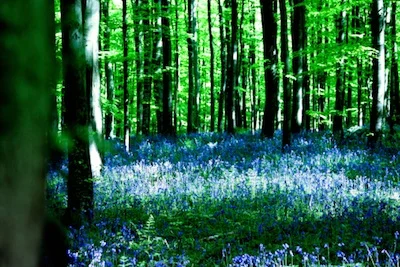Deciduous trees lose their leaves in autumn.
The leaves change colour before they fall.
The fallen leaves are good for the soil.
In spring, new leaves grow and the forest is green again.
The leaves are wide to catch more sunshine.
Deciduous forest in Canada©Getty Images
The term 'biome' means the main groups of plants and animals living in areas of particular climate patterns in different countries and includes the way in which animals, plants and soil interact together.
What plants can grow in an area is determined by the typical weather and seasons, and that in turn determines what kinds of animals can survive there.
The term 'deciduous' means 'to shed' - deciduous trees shed, or lose, their leaves once a year.
Why do deciduous trees shed their leaves?
The leaves of deciduous trees are broad and quite light. This gives the leaves a bigger surface to capture sunlight to help produce food for the plant. This is called photosynthesis (say foe-toe-sin-thess-sis). However, broad leaves are not good when the weather gets cold, as they lose too much moisture and get damaged. So the cooler autumn temperatures are a signal to the trees to cut off the water supply to the leaves and seal off leaf stems where they join onto the tree trunks. The leaves are not able to produce the chlorophyll (say claw-roe-fill) that makes them green. The leaves become yellow, red or gold before they dry up and fall off the trees. The leaves decay on the ground and make the soil very fertile.
Where are deciduous forests found?
This biome is located between the polar regions and the tropics, so large air masses from both cold and warm areas of the Earth affect the climate. Deciduous forests are found in the eastern part of the USA and large areas of Europe and parts of Asia.
There are four seasons in this biome, with warm summers and cold, often snowy, winters. There is about 90-180 cm of rain falling evenly through the year.
Snowy winter in a deciduous forest ©Getty Images
Many people live in this biome.
The soil in this biome is very rich because of the leaf decay. Because of this soil, and because of the long growing season the climate allows, many deciduous forests have been cut down to make way for farming.
Plants of the Deciduous Forest Biome
Spring in a deciduous forest ©Getty Images
Trees of this biome include hardwoods such as maple, oak, hickory, and beech.
There are often some evergreens, such as hemlock, spruce, and fir growing amongst them.
A deciduous forest generally has 3, 4 or even 5 layers of plants:
Top layer, or canopy: tall deciduous trees. Although the canopy is quite thick, it does allow sunlight to reach the forest floor, which encourages the other layers to grow.
The 2nd layer: saplings and shorter kinds of trees
The 3rd layer, or under-storey: shrubs.
The 4th layer: forest herbs, such as wildflowers and berries. In spring, before the leaves develop on the deciduous trees, these plants bloom and grow quickly while they are getting a lot of sunlight.
The 5th layer: mosses and lichens that grow on tree trunks.
Animals of the Deciduous Forest Biome
A pair of raccoons in a North American deciduous forest ©Getty Images
A wide variety of mammals, birds, insects, and reptiles can be found in the deciduous forest biome. There are different animals in the deciduous forests of different continents.
Mammals that can be found include bears, raccoons, squirrels, skunks, wood mice, and deer. Animals like bobcats, elk, bison, mountain lions, timberwolves, and coyotes used to be more commonly found in the deciduous forests, but their numbers have been affected by human activity.
Melting snow in spring and rain during summer provide water for streams and ponds.
Many water birds, insects, and fishes are found in this biome, along with amphibians such as frogs and salamanders, and reptiles such as lizards and small snakes.
Animal Adaptations
A red squirrel collecting nuts in autumn to store for winter. ©Getty
The animals have developed different ways of surviving in this biome. This is called adaptation.
Many of them migrate to warmer places to escape the cold winter. Others hibernate (a kind of sleep) through the winter when food is scarce.
A Eurasian brown bear in summer ©Getty Images
Some animals such as squirrels, chipmunks and jays store food when it is plentiful, using hollows of trees or buried in shallow holes as storehouses of nuts and seeds. In winter this store of food keeps them alive till spring.
These animals help the sustainability of the forest by losing some of their food stores. The buried nuts and seeds that are left in the ground sprout and grow, thereby adding new trees to the forest.
Read more about the deciduous forest biome:
www.mbgnet.net/sets/temp/index.htm
www.softschools.com/facts/biomes/temperate_deciduous_forest_biome_facts/161/








